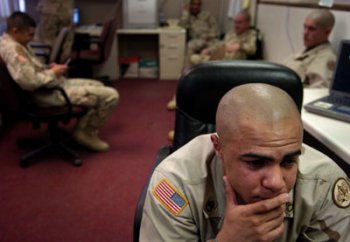
Chavez doesn’t pull any punches
Venezuelan president’s style surprises many, but foreign oil firms not leaving
SAN TOME, VENEZUELA – Touring a branch office in central Venezuela, an executive from the state-run oil company worked himself into a lather.
Why? Because there weren’t enough portraits of President Hugo Chavez hanging in the building.
“I want a nice, big photo of the president in the main entrance,” he barked at a press officer. “And that’s an order.”
Venezuela’s leftist president has sharply raised taxes on foreign oil firms and abruptly rewritten contracts, giving his government majority ownership and control over dozens of privately developed fields.
Last week, Chavez announced that his government will increase taxes from 34 percent to 50 percent on petroleum from the Orinoco basin and that royalties will double to 33.3 percent. On Thursday, the Venezuelan Congress, dominated by Chavez allies, recommended that the state convert the four Orinoco projects to joint ventures with the state oil company — known by the acronym PDVSA, pronounced pay-day-VAY-sa — assuming majority control and management.
Venezuela adopted similar changes last month on 32 smaller oil fields. Eventually, all petroleum operations in the country will be brought under majority government control, Oil Minister Rafael Ramirez said last week.
“Companies are making a lot of money taking oil from Venezuela,” Chavez said last Sunday on the radio. “For the next year, the extra revenue (for the government) looks like it will come to more than a billion dollars.”
Chavez said in Rome on Thursday ( May 11) in case of a military attack against Iran, no country in the world would have access to crude oil.
Chavez made the remark at a press conference, adding, “As Iran’s President Ahmadinejad has reiterated, if Tehran would come under attack, oil would get scarce for everyone.”
He also said that the US President George W. Bush should be put to trial at the international court of justice for having launched genocide in Iraq. “For all the horror it has created around the globe in the course of the past century, the United States’ war machine should be dismantled, since under the current conditions it is a threat against the entire mankind, particularly against our children.”
Chavez added, “The North American empire is the most cruel murderer regime that has ever come to power in world history and a serious threat for all nations.”
He believes the death of the United States had better taken place in the course of the 21st century, because “otherwise the entire world would face the threat of annihilation.”
Wild Thing’s comment……
March 4, ***…Chavez appoints radicals to head Venezuelan passport agency – reports of Arabs otaining ID documents*** CARACAS — Already facing allegations that Muslim extremists have obtained Venezuelan identity documents, President Hugo Chávez has put the country’s passport agency in the hands of two radicals — one a supporter of Saddam Hussein.
Hugo Cabezas and Tareck el Aissami were appointed last month as director and deputy director of the Identification and Immigration Directorate, in charge of border controls and issuing passports and national ID cards. The agency also works with electoral authorities on voter registration.
Both were top student leaders at the University of the Andes in the western city of Merida, described by senior school officials as a virtual haven for armed Chávez supporters and leftist guerrillas.
………Allegations that Chávez’s leftist government issued ID documents to Islamic radicals surfaced most recently in the newsweekly U.S. News and World Report. ”Venezuela is providing support — including identity documents — that could prove useful to radical Islamic groups,” the magazine reported last month, quoting senior U.S. military and intelligence officials…… ***
Chávez was the only head of state to visit Hussein in recent years — in 2000. He bitterly opposed the invasions of Afghanistan and Iraq and tried to have a postwar Iraqi delegation banned from OPEC meetings.
Islamic terror suspects in Britain up 50 percent since last year: report
(AFP)
The number of Islamic extremist security suspects in Britain has increased by 50 percent since the deadly suicide bombings in London last year, The Observer newspaper said on Sunday.
A senior intelligence source at the country’s domestic spy agency MI5 was quoted as saying that they were targeting 800 such suspects before the bombings on July 7 last year, but that figure now stood at 1,200.
In September 2001, the number of people deemed a “risk to national security” was 250, the newspaper said.
The unnamed MI5 source did not give a reason for the apparent rise in radicalisation but described the threat as “current, relentless and increasing”.
The Observer said a radical Islamic cleric whose sermons were attended by one of the July 7 bombers is to be released from prison ”within weeks” after serving just over half of a nine-year sentence for inciting murder and racial hatred.
Jamaican-born Abdullah el-Faisal once preached at the Brixton, south London, mosque attended by “Shoebomber” Richard Reid and Zacarias Moussaoui, the only man to be convicted in connection with the September 11, 2001 attacks.
He was convicted by a British jury in 2003 after his trial heard he had called for the murder of all non-Muslims and justified the use of nuclear and chemical weapons.
The newspaper said an order for his deportation was filed by the Home Office on March 30 but his lawyers have applied for his release on parole pending his removal.
Plane carrying Sen. Kennedy struck by lightning
BOSTON –A small jet carrying U.S. Sen. Edward M. Kennedy from a commencement speech in western Massachusetts to his Cape Cod home on Saturday was struck by lightning and had to be diverted to New Haven, Conn., a Kennedy spokeswoman said.
The eight-seat Cessna Citation 550 lost all electrical power, including communications, and the pilot had to fly the plane manually, according to Melissa Wagoner, Kennedy’s press secretary. No one was hurt.
The Massachusetts Democrat had just delivered the commencement address at the Massachusetts College of Liberal Arts in North Adams and was on his way from Pittsfield Municipal Airport to Hyannis to spend Mother’s Day with family when the plane was struck at about 4 p.m., she said.
The jet landed at New Haven at 4:11 p.m. without incident, said Federal Aviation Administration spokeswoman Arlene Murray. A report was filed with the agency, which will look into the incident, she said.
Kennedy planned to stay in Connecticut overnight because he is scheduled to deliver another commencement address at Springfield College on Sunday, Wagoner said
Wild Thing’s comment……
God is a Republican, you know.
“Oh, Ted, this is God. You’ve been flying off on tangents, and
going in the wrong direction for too long now.
This is my final warning.
Can you hear me now?”


For hundreds to re-enlist shows serious professionalism, said John Pike, director of the think tank Global Security. “It reflects well on the chain of command that people want to stick with it.”
At Army headquarters, Lt. Col. Bryan Hilferty, who monitors retention efforts, said “640 out of 5,000 soldiers is huge.”
The 3rd ACR commander, Col. H.R. McMaster, said “less tangible” factors such as knowing fellow soldiers “would die for you” drive re-enlistment. “Because of their combat experience,” he said, “these soldiers will be invaluable to our Army in the future.”
Not that soldiers decide easily.
“It’s not like I want to go back. But I enjoy what I do and the people I work with. You find work you enjoy, you stay with it,” said Staff Sgt. Dennis Busse, 29, who also served in Afghanistan with a wife and three kids back home.
“Money was the least of it” in deciding to stay with the 3rd ACR, which moves to Texas this year, said Busse, who worked previously as a cook at Italian and Mexican restaurants in his native Wisconsin.
“You’re always going to find difficulties. There are difficulties on the civilian side, too. The military seems to be closer. The difference is, the employers in the civilian world, some of the owners, they don’t want to do what they need to do. Here, anyone who’s above you has been where you are.”
A friend’s death
For Sgt. Heath Gadberry, re-upping was the last thing on his mind a year ago in Iraq. He remembers his 29th birthday there, when he was thinking: “What am I doing out here?”
A field medic, Gadberry had a college degree in outdoor recreation, was working online for a masters in health care administration, with a wife and three kids back home in Colorado.
“I was like: ‘What am I doing this for?’ ”
Then the next day, rolling through an insurgent hotbed south of Baghdad, a roadside bomb in an empty vehicle exploded as he passed, and everything went black. The blast killed his buddy, Spec. Robert Swaney, the gunner atop his Humvee.
It blew Gadberry 100 yards and with such force that the pavement he traveled over tore through his armor.
Once he was stitched and bandaged at base camp, Gadberry walked up to superiors and told them he wanted to re-enlist.
“Everybody looked at me like I was insane – ‘Of all people, you should know better,’ ” Gadberry said.
But Swaney’s death “motivated me,” he said. “How can I not do this? How could I pawn this off to somebody else?
“I’ve got other options. But I can’t imagine doing anything else right now. I’ve got to help get the job done.”

 Wild Thing’s comment…….
Wild Thing’s comment…….
Please click
the image above to see
the Video "Lazy Ramadi"

Wild Thing’s comment……
The most dangerous part of Iraq is still the region west of Baghdad, especially the city of Ramadi. Ramadi is a hell zone and U.S.-led coalition and Iraqi forces are trying to shut down insurgent supply routes into the area.
Wouldn’t it be something if instead of it being 72 Virgins, it was ONE virgin at 72. heh heh Bye Bye Insurgents! But of course the Democrats and terrorists will be deeply saddened at any deaths of the insurgents and the success of our troops.
 ……* Mudville Gazette
……* Mudville Gazette
Al-Qaeda video calls for “sea of blood” in revenge for Muhammad cartoons
News.com
A VIDEO by an al-Qaeda member posted on the Internet overnight calls on Muslims to attack Denmark, Norway and France for publishing cartoons of the Prophet Mohammed.
“Muslims avenge your Prophet …. We deeply desire that the small state of Denmark, Norway and France … are struck hard and destroyed,” said Libyan Mohammed Hassan, who escaped from US custody at Bagram airbase in Afghanistan last July.
“Destroy their buildings, make their ground shake and transform them into a sea of blood,” said Hassan, dressed in military fatigues and a black turban, and holding an assault rifle.
Hassan, also known as Sheikh Abu Yahia al-Libi, was one of four Arab terror suspects who broke out of the high-security detention facility at Bagram, the main US military base in Afghanistan.
Click image
below
to see Muhammad Cartoons
at my PC Free Zone Gazette page
Will U.S. Embassy in Iran become ‘Great Satan Park’?
Tourists and thrillseekers in Iran could have a new attraction in downtown Tehran: the former United States Embassy being converted into a “Great Satan Park.”
A top Iranian commander is calling for the creation of such a theme park at the one-time location U.S. facility, which has seen a troubled history dating back to the Carter administration of the 1970s.
“We would be able to nicely show off the American crimes to citizens strolling in the park,” General Mir-Faisal Bagherzadeh told the state-run Islamic Republic News Agency. “The former American Den of Spies should become the park of Great Satan.”
Bagherzadeh is in charge of the Sacred Defense Foundation, a propaganda organ originally created to commemorate the 1980-88 Iran-Iraq war.
The property is perhaps best known from 1979 news footage, when in the wake of Iran’s Islamic revolution that toppled the U.S.-backed shah, the embassy was taken over by Islamist students, with 52 staffmembers taken hostage for 444 days.
The downtown location is now used for military training by Iran’s ideological army, the Revolutionary Guards, while the main building also serves as a museum to display the “documents of American espionage and crimes against the Islamic Republic of Iran.
Wild Thing’s comment……
Yep keep pushing our buttons Iran. Poor little glow in the dark Ahmadinejad wanna be world ruler.
Here ya go……Click on image below turn up volume to hear Samuel Jackson quote Ezekiel 25:17 passage from movie Pulp Fiction
Recent Comments